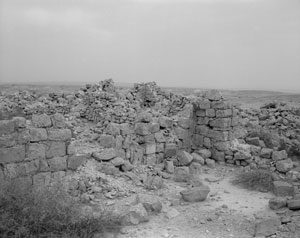Ya’ari documents the sites of the Nabataean towns Shivta and Haluza in the Negev. Shivta, built in the first century BC was abandoned by the Nabataean. Between the fifth and the seventh century Shivta flourished once again as a Byzantine – and later a Muslim – agricultural desert town. Today its name is widely recognized as an IDF training base. The town Haluza was built in the third century BC and served as a stopover for travelers between Petra and Gaza port. Haluza was a central town during the Roman and Byzantine periods. The houses of the village Al Khalsa as well as the houses of Be’er-Sheva’s old city were constructed of the remains of Haluza, of the ancient stones of this Nabataean town.
Ya’ari examines the efforts of archaeological reconstruction, as he records the gradual disintegration of the weary, petrified and suspended, almost fossilized structures. His photographs document the ancient beauty of the ruins and unveil the traces of action and failed, yet touching, efforts to try and look after the sites.
Courtesy of the artist and Sommer gallery, Tel-
Less Reading...

